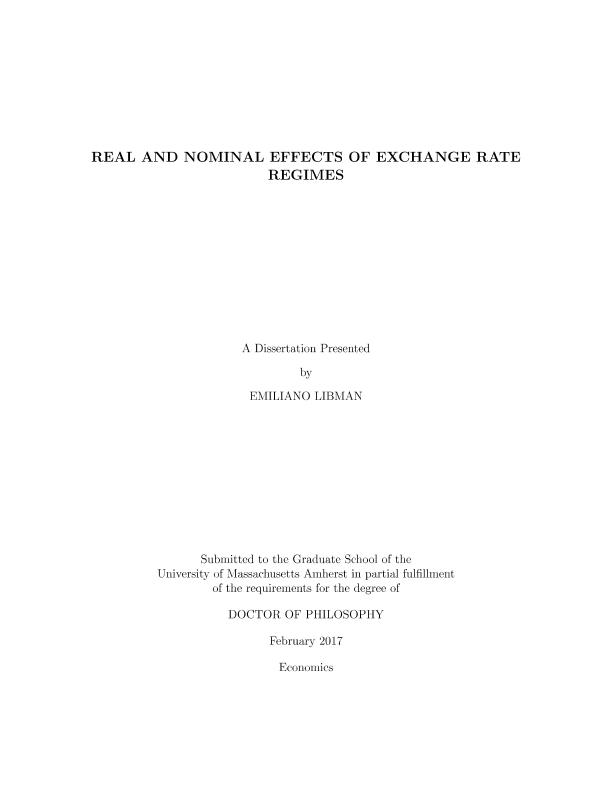Mostrar el registro sencillo del ítem
dc.contributor
Razmi, Arslan
dc.contributor.author
Libman, Emiliano

dc.date.available
2019-09-06T18:05:16Z
dc.date.issued
2016-12-12
dc.identifier.citation
Libman, Emiliano; Razmi, Arslan; Real and Nominal Effects of Exchange Rate Regimes; 12-12-2016
dc.identifier.uri
http://hdl.handle.net/11336/83051
dc.description.abstract
This dissertation explores some of the macroeconomic effects of exchange rate regimes and the role of real exchange rate on capital accumulation and growth. The first essay analyzes the factors that promotes episodes of accelerated capital accumulation that last seven years or longer. After identifying 189 such episodes, I rely on econometric analysis to explore: (i) the conditions that increase the likelihood of an episode taking place, (ii) the presence of structural change during episodes, and (iii) the characteristics that distinguish episodes that are sustained beyond the final year from those that are not. Turning points in investment tend to be preceded by fast growth, stable and undervalued currencies, low inflation, and low capital inflows, especially on the portfolio account. During the episodes, economies experience a shift in their economic structure, from agriculture toward the manufacturing sector. Sustained episodes seems to be related to trade openness, low incidence of macroeconomic crises, a relatively closed capital account, and low dependence of natural resources, but these results are not very robust. The second essay explores the relation between exchange rate regimes and real exchange rate misalignments in an unbalanced panel of 100 countries, spanning the period 1979-2010. The propensities to adopt a particular exchange rate regime are estimated using different exchange rate regime determinants, and the results are used to create a control group to compare with the countries that adopt a peg. The comparison of countries that use pegs with countries that have similar characteristics, but use more flexible arrangements, suggest that pegs are associated with more overvaluation. The results are robust to different exchange rate regime classifications, misalignment indexes, and matching estimators. The third and final essay discusses the effects of Inflation Targeting in LatinAmerican countries during the period 2000-2015. Some authors have argued that there is a flaw in the way in which the system has been conducted in the region. In good times, the Central Banks are reluctant to cut interest rates, but in bad times they are willing to raise interest rates very aggressively, adding a procyclical bias to monetary and exchange rate policies. Using different econometric techniques, I find that these Central Banks, with the exception of Chile, suffer from “fear of floating” (i.e., the Central Bank combat depreciations more aggressively than appreciations), and that this is more pronounced for the case of Brazil and Mexico, as the literature have argued.
dc.format
application/pdf
dc.language.iso
eng
dc.rights
info:eu-repo/semantics/openAccess
dc.rights.uri
https://creativecommons.org/licenses/by-nc-sa/2.5/ar/
dc.subject
Real Exchange Rates
dc.subject
Exchange Rate Regimes
dc.subject
Capital Accumulatio
dc.subject
Inflation Targeting
dc.subject.classification
Economía, Econometría

dc.subject.classification
Economía y Negocios

dc.subject.classification
CIENCIAS SOCIALES

dc.title
Real and Nominal Effects of Exchange Rate Regimes
dc.type
info:eu-repo/semantics/doctoralThesis
dc.type
info:eu-repo/semantics/publishedVersion
dc.type
info:ar-repo/semantics/tesis doctoral
dc.date.updated
2019-09-04T15:07:46Z
dc.description.fil
Fil: Libman, Emiliano. University of Massachussets; Estados Unidos. Consejo Nacional de Investigaciones Científicas y Técnicas; Argentina. Centro de Estudios de Estado y Sociedad; Argentina
dc.conicet.grado
Universitario de posgrado/doctorado

dc.conicet.titulo
Doctor en Filosofía
dc.conicet.rol
Autor

dc.conicet.rol
Director

dc.conicet.otorgante
University of Massachussets

Archivos asociados
